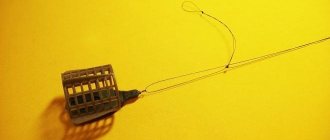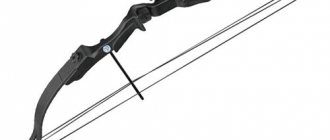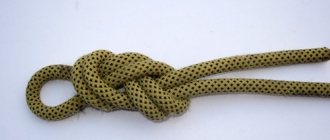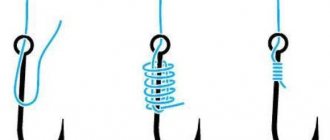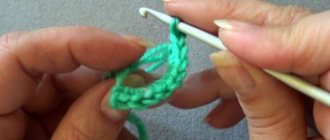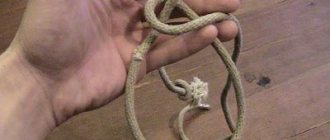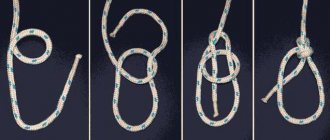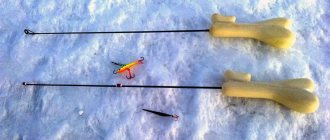Feeder installation Gardner loop is the equipment that most feeder operators start with due to its ease of knitting and efficiency. Some fishermen confuse this installation with the classic paternoster. This is partly true; the Gardner paternoster is a variety of a number of similar rigs.
The main problem for beginners is the leader twisting around the main line or getting caught during casting. However, with proper installation such problems do not arise. In this article, we will consider in detail the features of installing the Gardner paternoster and the nuances of its use in feeder fishing.
Feeder equipment
A Gardner loop for a feeder can be knitted on a pond in just a couple of minutes. To do this, you do not need special knots or additional fishing accessories - the main fishing line and the fisherman’s hands. That is why this installation is popular among fishermen. However, the Gardner paternoster is not universal - it is just one of several effective types of feeder equipment.
In various fishing conditions, the Gardner rig works better, in others, an asymmetrical loop, and thirdly, the installation of a running feeder (inline). The angler's job while fishing is to figure out what works best under those particular conditions. Therefore, you need to master all the basic feeder equipment. Article about feeder installations:
Gardner's loop is a type of paternoster
- The feeder equipment is a Gardner loop in terms of the mechanics of its operation - the same as a paternoster, or in our opinion - a blind feeder at the end of the fishing line and a retractable leash. It’s just that, unlike the bottom outlets we are used to, this equipment is more effective. A hook is made to the leash from a thick fishing line, the same one that is used as the main one.
- The length of the branch exceeds the length of the fishing line to the feeder and ends with a loop into which the leash is attached. In general, the leash together with the outlet turns out to be much longer than the distance from the point of its attachment to the base to the feeder. But, thanks to the thick, rigid and long lead, it does not get tangled when casting or reeling in the feeder.
- The Gardner paternoster for the feeder differs from the classic one only in that the outlet to the feeder is made on a loop. In the classic form, this shoulder is made from a weaker and thinner fishing line - specifically so that when hooked, the feeder comes off, and not the leash with the fish.
- According to legend, the famous fisherman Steve Gardner from England came up with this rig when he watched his wife while fishing for a long time could not tie a regular installation on a tap. In England, this editing is simply called “Loop”, which means “loop”. And already in our country this type of paternoster is called the Gardner loop.
Gardner's paternoster
Which is better, a Gardner's loop or a classic paternoster? In terms of operation, these are absolutely identical installations. The Gardner rig is easier to knit - one knot to form a loop. At the remaining end there is a loop for a leash. We don't need the function of tearing off the feeders. On the contrary, it’s better to let the fish come off when hooked than to tear off an expensive feeder. It’s just that the classic paternoster comes from England, from a time when feeders were not yet used, and losing a cheap sinker instead of a fish was considered normal there. Read more about paternoster feeder equipment.
Regular paternoster
Features of the Gardner loop
The equipment is named after Steve Gardner, a floater and feeder who brought this type of feeder installation to the masses. Undoubtedly, earlier fishermen fished with similar gear, but only Steve was able to introduce the paternoster to a wide range of fishermen. Today this type of gear is considered the simplest and most widely used.
The Gardner loop has found application not only in classic, familiar to everyone, feeder fishing. Fishermen successfully install ordinary donks using this installation
. The anti-twist bars and iron bends have been replaced by a pigtail, which is easy to install and easy to use.
You can simply replace the feeder with a classic weight
. Many people catch roach with this type of gear in the spring. In the spring, the use of bait sometimes simply turns out to be unnecessary fuss. Therefore, most fishermen simply refuse it.
The main difference between this gear is that the fish hooks itself when it bites.
. As the fish swallows the bait, the line begins to tighten, and the hook occurs as a result of the leash hitting the feeder. All that is required of the fisherman is to hook the fish additionally and pull the trophy ashore.
But this property manifests itself only when the fish is sufficiently active; if it is passive, then the paternoster will only bring idle bites. With little activity, bream and other white fish will simply spit out the bait after they feel a slight resistance. There is only one salvation from idle bites - increase the length of the leash
. But this trick doesn’t always work, and sometimes you have to completely change the equipment.
Application on a pond
As already mentioned, the Gardner loop paternoster is an effective and simple equipment, but not a panacea. The main advantage is sensitivity. However, due to the peculiarities of the installation, this sensitivity is preserved only in comfortable or moderately difficult fishing conditions - there is no strong current, kinks of the main line over the edge, etc.
For the sensitivity of the Gardner equipment and, in general, any paternoster, it is important that there is direct contact between the quivertype and, in fact, the installation. Then all the smallest touches of the fish on the bait are transferred to the tip of the feeder. If the line is blown into an arc by the current, or it bends at the bottom on the upper part of the edge, the bites are no longer transmitted so clearly. In difficult fishing conditions, it is better to use an asymmetrical loop or inline.
Fishing with a Gardner loop is effective when the fish tries the bait and takes it completely in place, then swims away. This equipment will not work well when the fish does not take the bait properly, and large hooks are used - for example, it slightly grabs the bait with its lips and tries to swim away without swallowing it.
In this case, when hooking (or when the fish picks up the slack from the hook to the feeder), the effect is “kicked in the teeth.” This often happens when fishing for roach. Treatment is to install small hooks and a longer leash. If, on the contrary, the bite is good, if the hook is too deep in the fish’s mouth and it is difficult to remove it, you need to shorten the leash and the outlet to the feeder, and hook a little earlier.
Testing during fishing
Therefore, theoretically, apart from the reservoir, it is impossible to say which is better, an asymmetrical loop on the feeder or a Gardner loop (or inline). Under different conditions, one or another installation works better. Each rigging method has its own advantages and disadvantages, which are learned with experience.
The further you cast, the larger the loop you need to make. But as this element increases, the risk of entanglement increases; the lead to the leash will also have to be made longer. For ultra-long casts, it is better to use inline or asymmetrical equipment. However, at close and medium distances the paternoster is very sensitive, and it is also easy to knit.
In a strong current with a long line to the feed and a short leash, the hook with bait may not touch the bottom at all, but hover above it. This can be used, for example, when fish are attracted to the bait not on the bottom, but dangling in the stream. For roach this is rather a favorable option, but not for bottom bream or crucian carp. But when fishing there are always exceptions - sometimes even bream or crucian carp prefer a rig dangling with the current (or slowly sinking, on a longer leash).
With the Gardner rig you need to work short - literally, with the butt of the feeder in your hands or on your knee. Self-notching rarely occurs. If you don’t have time to hook, the fish will spit out the bait. Therefore, this installation is for lovers of tempo active fishing with tackle in hand. If the feeder is placed on a stand, and the angler sits a little further from the gear, it is better to use self-cutting rigs (asymmetrical, inline with a stopper on the rod side).
Do-it-yourself tackle installation
It is extremely easy to knit a paternoster with your own hands, even on the spot, right next to a pond. The equipment gained its popularity due to a certain versatility in use. That is, it is good for both long and close casts, both on the current and in still water.
How to make a Paternoster correctly? The diagram is below.
Paternoster
Required items:
- Twisting;
- Swivel;
- Fluorocarbon line;
- Braided 0.1-0.14 mm;
- Closed / semi-closed feeder with a load (obviously loaded) 100-120 grams for current, 40-100 for standing water.
Installation
Make it a rule, on every fishing trip, the first thing you do is...
The entire tackle is connected to the main line using a “Loop to Loop” connection. Make a loop using a surgical knot.
The main line of the rig (0.3 mm) goes to the twisted connection. One part of the twist goes to the feeder, the other to the leash. The length of the twist to the feeder is 20 cm. To the leash – 10 cm.
The feeder is attached to the twist with a swivel and a carabiner, or a wrapping loop. The twist going to the leash is also attached through the “Loop to Loop” connection. The length of the leash is 50-100 cm. The leash is connected to the hook with a Sliding Snood, if the hook does not have a loop, or with a Double Palomar, if the hook has a loop. You can use two hooks when an additional hook is also attached to the twist. However, this will not be a classic Paternoster, but a modernized one.
Do not try to connect the fishing line and the leash by burning, otherwise a break is inevitable.
Gardner's loop
The Gardner Paternoster rig differs from the classic one in that it has a sliding loop, which reduces the chance of tearing and overlap.
Required items:
- Twisting;
- Swivel;
- Fluorocarbon line as a leader, 0.14-0.22 mm;
- Braided 0.1-0.14 mm;
- Closed/semi-closed feeder.
The equipment is attached to the main line with a surgical loop. You tie a 20-30 cm loop to the feeder, the feeder is fixed in the middle of this loop using locking beads or rubber bands. Then, using a loop-to-loop connection, the main line is connected to the leader. The leash is made of fluorocarbon, 0.14-0.22 mm. The hook is attached with a Snood or Double Palomar.
Installation of Paternoster Gardner according to Fadeev, video
Fadeev described in detail the structure of Paternoster's tackle.
Gardner's sliding paternoster
Few people know, but a sliding Paternoster is a possible option. Place the stopper on the leash side only, using stopper beads or elastic. Then comes the twist, the end of which is attached to the leash using a loop-to-loop connection. The twist can be replaced with a feedergum rubber band, this will increase the sensitivity of the tackle.
The sliding rig is attached to the main line using a carabiner or loop-to-loop connection. Then comes a fishing line 30-40 cm long. A feeder is attached to the fishing line through a swivel, and immediately after it a stopper. After this there is a twist of 10-15 cm or a feeder. The leash is made of fluorocarbon, 50-100 cm long
Read How to salt trout at home with salt and sugar
It is important to use leashes of faded colors, such that they do not catch the fish’s eyes. The feeder is attached to the fishing line with a swivel and carabiner
How to knit a Gardner loop correctly
The whole idea of installing a gardner, which distinguishes it from a regular bottom short lead, is a long lead that allows the rig to not get tangled or twist on the main line when reeling in or casting. The lead to the leash is always made longer than the arm with the feeder - this is a key feature during installation.
Requirements for a correct Gardner loop:
- A lead on a leash longer than a shoulder with a feeder.
- Installation should be made of rigid monofilament or fluorocarbon. If you do it with braid or soft fishing line, there is a high probability of tangling.
- It is necessary to avoid protruding elements on the feeder clasp and knots. For example, when forming a loop on a leash, the excess tip is cut off to the root. All these protrusions increase the likelihood of entrapment.
When these requirements are met, no tangles or overlaps will occur. You can often find similar diagrams on the Internet:
Gardner rig on braid
However, the braid is soft, and tangling in such equipment cannot be avoided. There will be less tangling with soft, careful casts at short distances. Gardner's braided rig is a backup emergency option when you need to re-connect the installation on a pond, and a piece of 0.3 mm rigid monofilament is simply not available.
You can tie the feeder to the Gardner loop on the feeder simply with a loop in the eye. However, this is also an emergency option if there is no swivel - when reeling in with a spinning reel, such equipment will twist the line. Therefore, it is better to use a swivel with a carbine. In addition, the feeder fishing technique involves selecting the weight of the load during the fishing process. The fastener makes it quicker and easier to change cords. We tie a loop to the swivel as usual. However, there is no need to tighten it - again, for a possible quick change. It is better to leave the base of the loop on the body of the swivel.
Easy installation
Let's look at how to knit a Gardner paternoster for a feeder. The process is incredibly simple.
- We fold the fishing line in half, retreat the required length (depending on the required distance from the leash knot to the feeder, usually from 7 to 20 cm), tie a figure eight knot. You can use a surgical knot (simple double or triple). It turns out to be a loop and two ends. One is the main fishing line, or a branch for attaching to the cord (when using braid as the main one). The second one is on a leash.
- We attach the feeder.
- We measure the length of this bend.
- We tie a loop for the leash, so that in the finished version the lead to the leash is longer than the arm with the feeder.
- We attach a leash with a hook to the outlet loop.
The Gardner loop is knitted on the knee without using any twists or beads or stoppers. In principle, a Gardner loop can be knitted on wood and braid. But on a cord, as already mentioned, the bend will not have the necessary rigidity characteristics, which leads to overlapping and tangling.
Twisted equipment
If there is no rigid monofilament, or you have to install it on a braided line, the elbow can be tied in the form of a twist to prevent tangling. This will somewhat reduce the likelihood of tangling, and when using hard material, it will almost be reduced to zero. This installation of a Gardner loop is more complicated - you still need to somehow tie the feeder twist to the braid or main line.
If you start knitting with a twist, you will get two bends after it. One is for the main line, the other is for the feeder. However, this will no longer be a Gardner loop rig, but a regular paternoster. The feeder is made not on a double line, but on a single line. In principle, this does not matter - the main thing is not to get confused. This version of the Gardner loop for a feeder with twisting is a solution for constant entanglements (in fact, a regular paternoster with twisting).
Fidergam
Another option for a Gardner loop for a feeder is with a piece of feeder rubber. If everything is fine, the equipment is made of rigid monofilament and does not get tangled, the feeder is added simply as an insert between the leash and the outlet on it. All this is located below the feeder, and therefore does not overlap. However, if you don’t want or can’t knit a Gardner loop correctly (for example, you don’t have rigid monofilament), you can make it directly on the braid.
Diagram of insertion in paternoster
We make a standard loop, attach the feeder to it, and cut off the end of the leash completely. We tie a piece of feedergam onto the braided line just above the outlet of the feeder using a regular triple knot. Then at this place we tie a regular knot of the main cord - so that the rubber does not slide along the base. We make the outlet entirely from elastic according to all the canons - longer than the arm of the feeder.
We tie a loop on the leash at the other end of the elastic band. This option is good only for short branches to the feeder - 7-10 cm. Otherwise, the piece of feedergam will need to be made too long - it will stretch very much. Elastic rubber in this installation lowers the leash below the feeder, such equipment does not get tangled when casting.
Gardner's sliding loop
Some sources indicate sliding installation schemes with a feeder on the outlet, calling it a “sliding paternoster”. However, this is essentially a Running Feeder Rig with a tap. And this outlet should be made not from a loop - but in the form of a fluorocarbon twist. Therefore, if you want to tie a Gardner loop to a feeder in a sliding version, see the article about online feeder equipment.
Knots for spinning lures
For spinning lures, hook knots that are not tied around the shank are suitable:
- Palomar;
- stepped;
- “Clinch” (grabbing) and double “Clinch”;
- deaf (cape method);
- "Shark's";
- "Crawford"
- Twisted Dropper Loop;
- Scaffold Knot;
A double stevedoring knot for attaching various baits when fishing with a spinning rod, this knot is ideal. 100% - its reliability.
Read Fishing on the Krasnoyarsk Sea
“Eight” is the simplest knot for creating a loop, into which you can then insert any bait using the cape method. This makes it very convenient to change bait from one to another.
Uni-knot is also very strong and easy to tie.
Uni-knot is also very strong and easy to tie. A knotless connection for spinning lures is a fastener that does not spoil the play of the bait and firmly attaches it to the braid.
How to deal with beards on braided fishing line - no more tangling of braided line. Spaced spinning rigs: Moscow, drop-shot.
Separate installation or on the main cord
Such manufacturing options are not based on the wishes of the angler, but on the obvious issue of functionality - the absence of tangling and twisting. You can knit a tackle with a Gardner feeder loop directly on the main monofilament or shock leader, if they have the required stiffness characteristics. That is, it is a rigid feeder line or fluorocarbon. Then no entanglements occur. All other options are a search for working options against such entanglements.
If soft fishing line or braid is used as a base or shok leader, we knit a Gardner fishing loop as a separate installation, from the same fluorocarbon or hard monofilament. Then we attach all the equipment to the base. As an option, the entire section to the feeder is made of wattle, and the outlet is made of feeder rubber.
We use a whole braided bundle only out of desperation - when there are no hard materials. And only with a soft casting technique and not over long distances - otherwise overlapping and twisting cannot be avoided.
